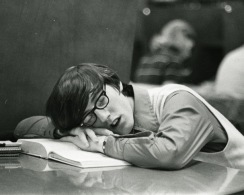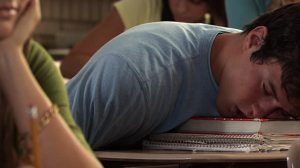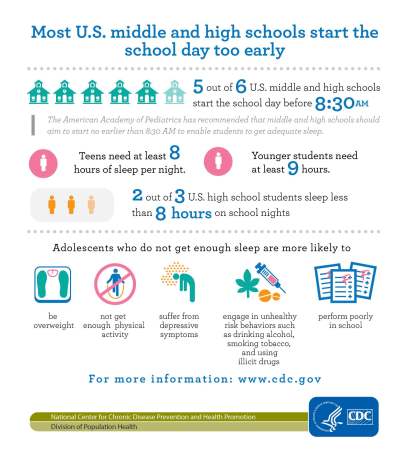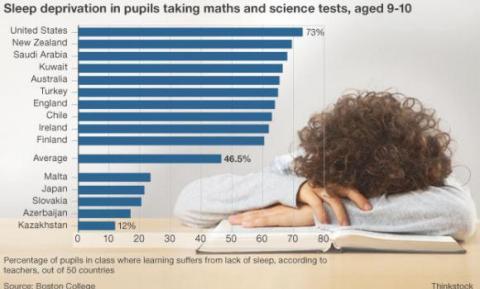I. The Prevalence of Restricted Weeknight Sleep Among Adolescents
“Almost all teenagers in this country are sleep-deprived.” (96)—Maida Chen, M.D., Assistant Professor of Pediatrics, University of Washington School of Medicine, Assistant Director, Pediatric Sleep Disorders Center, Seattle Children’s Hospital.
During the school year, the great majority of high school students are getting insufficient sleep. (25, 26, 27, 97, 98, 99) The 2011 Centers for Disease Control and Prevention (CDC) Youth Risk Behavior Surveillance System (YRBSS) survey of 15,425 high school students in the 50 States and the District of Columbia found that on an average school night, 7.5% obtain optimal sleep (>9 hours), 23.9% report “borderline” sleep (8 hours), and 68.6% report insufficient sleep (<8 hours). (99) The 2011 National Sleep Foundation poll found only 14% of teenagers between the ages of 13 and 18 reported getting 9 or more hours of sleep on weeknights. (25)
A 2009 study of 384 students from 3 Midwest high schools found 91.9% slept less than 9 hours on school nights, with 10% sleeping less than 6 hours each night. (100) The same year, one in three Philadelphia middle and high school students reported falling asleep in school. (105) The 2007 CDC Youth Risk Behavior Survey found that nationwide, on an average school night, 68.9% of high school students reported sleeping less than 8 hours, 23.5% reported getting 8 hours, and 7.6% reported getting 9 or more hours. (26) The CDC Survey also found that on weeknights, 31.1% of the students reported getting 8 or more hours of sleep; 42% of ninth graders did so versus only 22% of 12th graders. (97) The 2006 National Sleep Foundation poll found only one in five adolescents in grades 6-12 getting the recommended 9 or more hours of sleep per night. (98, 101)
 Studies have shown sleep deficiency on school nights as prevalent for the better part of the last three decades. Researchers comparing data from 1981 and 2003–2006 found that bed times and wake times were similar, with teens averaging 8-8¼ hours sleep on school nights. (28) In a 1994 survey of high school students, 26% reported sleeping less than 6.5 hours on school nights, while only 15% reported sleeping 8.5 hours or longer. (55) In 2002, teenagers averaged 7.5 hours sleep on school nights, with a quarter of them getting only 6.5 hours per night. (102) Scientists writing in the June 2005 issue of Pediatrics observed, “Both short-term and long-term strategies that address the epidemic of sleep deprivation among adolescents will be necessary to improve health and maximize school performance.” (6, italics added.)
Studies have shown sleep deficiency on school nights as prevalent for the better part of the last three decades. Researchers comparing data from 1981 and 2003–2006 found that bed times and wake times were similar, with teens averaging 8-8¼ hours sleep on school nights. (28) In a 1994 survey of high school students, 26% reported sleeping less than 6.5 hours on school nights, while only 15% reported sleeping 8.5 hours or longer. (55) In 2002, teenagers averaged 7.5 hours sleep on school nights, with a quarter of them getting only 6.5 hours per night. (102) Scientists writing in the June 2005 issue of Pediatrics observed, “Both short-term and long-term strategies that address the epidemic of sleep deprivation among adolescents will be necessary to improve health and maximize school performance.” (6, italics added.)
In 2008, Norwalk Hospital sleep experts noted that the “often serious impact of this chronic under-sleeping is now evident in both high school and middle school students. … This pattern of rising sleep debt during the week followed by weekend catch-up still leaves most teens sleep-deprived by an estimated 10 hours sleep per week.” (2) In 2009, writing for the journal Developmental Neuroscience, researchers reiterated, “Sleep deprivation among adolescents is epidemic.” (103; see also, n. 107 [“Chronic insufficient sleep has become a virtual epidemic among adolescents in the United States.”] p. 11; Terman & McMahan, Chronotherapy: Resetting Your Inner Clock to Boost Mood, Alertness, and Quality Sleep (Penguin Group 2012) [“Sleep deprivation is an epidemic among adolescents.”] p. 197.) Scientists analyzing YRBSS data gathered from U.S. high school students in 2007, 2009, 2011, and 2013, found that only 6.2% to 7.7% of females and 8.0% to 9.4% of males reported obtaining 9 or more hours of sleep. (141) Consistent with prior reports, (67) the percentage of students obtaining an insufficient amount of sleep increased as students progressed from grades 9 to 12. Among 12th graders, approximately 95% of males and females obtained less than 9 hours of sleep. (141)
 “Sleep deprivation among adolescents appears to be, in some respects, the norm rather than the exception in contemporary society.” (27) “Because of a multitude of intrinsic and environmental factors, adolescents are particularly vulnerable to disturbed sleep, and are one of the most sleep deprived age groups in the country.” (40) It has been shown that “adolescents’ increased sleepiness is similar to the clinical level of sleepiness presented by patients with severe sleep disorders.” (104) ”In many cases, the levels of sleepiness in high school students are near the threshold seen in sleep disorders such as narcolepsy or sleep apnea.” (Cardinali, Chronoeducation: How the Biological Clock Influences the Learning Process, publish. in, The Educated Brain: Essays in Neuroeducation (Battro, Fischer, & Léna, edit., Cambridge Univ. Press 2008) p. 121, citation omitted.)
“Sleep deprivation among adolescents appears to be, in some respects, the norm rather than the exception in contemporary society.” (27) “Because of a multitude of intrinsic and environmental factors, adolescents are particularly vulnerable to disturbed sleep, and are one of the most sleep deprived age groups in the country.” (40) It has been shown that “adolescents’ increased sleepiness is similar to the clinical level of sleepiness presented by patients with severe sleep disorders.” (104) ”In many cases, the levels of sleepiness in high school students are near the threshold seen in sleep disorders such as narcolepsy or sleep apnea.” (Cardinali, Chronoeducation: How the Biological Clock Influences the Learning Process, publish. in, The Educated Brain: Essays in Neuroeducation (Battro, Fischer, & Léna, edit., Cambridge Univ. Press 2008) p. 121, citation omitted.)
A survey of 270,000 adolescents from 1991 to 2012 found the “proportion of adolescents who regularly obtain >7 hours of sleep is decreasing.” (149) The age-specific probability of regularly obtaining >7 hours of sleep generally decreased across age, with 18- to 19-year-olds least likely to report sleeping for 7 or more hours. (149) The shortfall is worse among girls, African-American and Hispanic teens, and teens with lower socio-economic status. (149)
In 2010, the American Academy of Sleep Medicine and the American Medical Association passed a joint resolution identifying “adolescent insufficient sleep and sleepiness as a public health issue[.]” (54.9) In 2013, University of California psychologists cautioned, “The epidemic of insufficient sleep among adolescents is particularly alarming given the accumulating evidence that sleep is needed to support optimal cognitive and emotional functioning.” (146) In August of 2014, the American Academy of Pediatrics issued a Policy Statement acknowledging “insufficient sleep in adolescents as an important public health issue that significantly affects the health and safety, as well as the academic success, of our nation’s middle and high school students.” (54)
 Multiple factors contribute to sleep deficiency in teens, including electronic devices, jobs, erratic sleep schedules, caffeine, social and school obligations. (21, 29, 59, 105, 106, 108) Restricted sleep, however, is primarily limited to school nights, rather than weekend nights, (21, 22, 26, 28, 29, 30, 55, 101, 102, 109, 110) with students losing 2 hours or more of sleep each night after the start of school. (2, 6, 107, 107.5, Mindell & Owens, Clinical Guide to Pediatric Sleep: Diagnosis and Management of Sleep Problems (Lippincott Williams & Wilkins, 2nd ed. 2010) p. 258.) A Boston College forty-nine nation comparison undertaken in 2013 found the United States to have the highest number of sleep-deprived students, with 73% of 9- and 10-year-olds and 80% of 13- and 14-year-olds identified by their teachers as being adversely affected. (110.4, 110.5)
Multiple factors contribute to sleep deficiency in teens, including electronic devices, jobs, erratic sleep schedules, caffeine, social and school obligations. (21, 29, 59, 105, 106, 108) Restricted sleep, however, is primarily limited to school nights, rather than weekend nights, (21, 22, 26, 28, 29, 30, 55, 101, 102, 109, 110) with students losing 2 hours or more of sleep each night after the start of school. (2, 6, 107, 107.5, Mindell & Owens, Clinical Guide to Pediatric Sleep: Diagnosis and Management of Sleep Problems (Lippincott Williams & Wilkins, 2nd ed. 2010) p. 258.) A Boston College forty-nine nation comparison undertaken in 2013 found the United States to have the highest number of sleep-deprived students, with 73% of 9- and 10-year-olds and 80% of 13- and 14-year-olds identified by their teachers as being adversely affected. (110.4, 110.5)
In 2015, CDC scientists reported the proportion of students who get enough sleep has remained approximately 31% since 2007, the first year that the national Youth Risk Behavior Survey included a question about sleep, meaning that more than two thirds of high school students do not get enough sleep. (53.5)
Students lose even more sleep in the spring. Following the March shift to Daylight Saving Time (DST), high school students starting school at 7:40 a.m. in Westchester County, New York, lost an average of 32 minutes of sleep per weeknight during the first week; i.e., mean sleep duration declined from 7 hours 51 minutes to 7 hours 19 minutes. Psychomotor vigilance scores also fell significantly after the change to DST. (110.7)
Sleep deficiency in adolescents is associated with:
- profoundly impaired learning capacity, memory, and alertness (11, 21, 27, 29, 111, 112, 113, 114, 115, 116, 117, 117.5)
- depression, anxiety, fatigue (29, 118, 119)
- increased risk of suicidal ideation and completed suicide (53, 120, 121, 122, 123, 124)
- increased frequency of automobile accidents (31, 46)
- decreased athletic and motor skills (125, 126)
- excessive weight gain (127, 128, 129, 130)
- increased likelihood of risk-taking behaviors, including drug or alcohol use (53, 131, 132)
- increased likelihood of criminal conduct (133)
- physical, psychological, or social difficulties (134, 135, 136)
- elevated blood pressure (137)
- increased risk of diabetes (138, 139)
- cardiovascular risk (140)
- interference with secondary brain development, (64, 142) etc.
These findings generally appear to apply equally to young adults, (24, 40, 136, 143) and, with the obvious exception of driving accidents, to middle school children as well. (22, 23, 30, 44) “In light of these myriad negative effects on adolescent health and well-being, the identification of potentially modifiable factors that escalate the risk of insufficient sleep in this population is an important public health issue.“ (41)
“The vast majority of adolescents do not get enough sleep. Research has shown that the average teenager needs 9 to 9¼ hours of sleep a night. This is not all that much less than school-aged children need. However, the average amount of sleep that teenagers get is about 7 hours on school nights. Even on weekends and holidays, when they try to ‘catch-up,’ teenagers average just 9 hours of sleep. This leads to teenagers missing an average of 2 hours of sleep per night, and it accumulates over time.” (Mindell & Owens, Clinical Guide to Pediatric Sleep: Diagnosis and Management of Sleep Problems, supra, p. 258.)
This two hour or more (65) discrepancy between weekend and school-night sleep has caused researchers to consider the relationship between pedagogical structures and adolescent biology. (2, 5, 6, 21, 23, 24, 26, 30, 31, 41, 44, 46, 99, 115, 116, 131, 138, 145) As will be discussed, it is the widely held view of sleep experts that “the loss of sleep throughout adolescence results from the combination of the adolescent delayed sleep phase, which promotes later bedtimes, and unchanged early school start times which restrict the amount of time available for adolescents to sleep.” (147)

